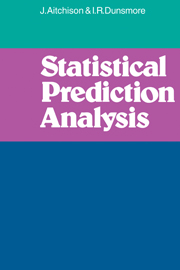Book contents
- Frontmatter
- Contents
- Preface
- 1 Introduction
- 2 Predictive distributions
- 3 Decisive prediction
- 4 Informative prediction
- 5 Mean coverage tolerance prediction
- 6 Guaranteed coverage tolerance prediction
- 7 Other approaches to prediction
- 8 Sampling inspection
- 9 Regulation and optimisation
- 10 Calibration
- 11 Diagnosis
- 12 Treatment allocation
- Appendix I
- Appendix II
- Bibliography
- Author index
- Subject index
- Example and problem index
11 - Diagnosis
Published online by Cambridge University Press: 12 October 2009
- Frontmatter
- Contents
- Preface
- 1 Introduction
- 2 Predictive distributions
- 3 Decisive prediction
- 4 Informative prediction
- 5 Mean coverage tolerance prediction
- 6 Guaranteed coverage tolerance prediction
- 7 Other approaches to prediction
- 8 Sampling inspection
- 9 Regulation and optimisation
- 10 Calibration
- 11 Diagnosis
- 12 Treatment allocation
- Appendix I
- Appendix II
- Bibliography
- Author index
- Subject index
- Example and problem index
Summary
The nature of a diagnostic problem
Although for this chapter we have used a title which has often a medical connotation the problem arises in many other fields – for example, in the diagnosis of a fault in a complex industrial process, in categorising an archaeological or anthropological specimen. From an expository point of view, however, the nature of a diagnostic problem is most easily described, and the corresponding theory is best developed, within the context of a specific situation. For this purpose we have selected a medical problem concerning the differential diagnosis of three forms or types of a particular syndrome on the basis of two diagnostic tests or observable features. We have deliberately selected this three-type two-feature problem because it allows the maximum exploitation of diagrammatic means of expressing concepts and analyses. All the concepts and analyses carry over straightforwardly into higher dimensional problems. Indeed the introductory illustrative problem which we now present is a subproblem extracted from a larger real one.
Example 11.1
Differential diagnosis of Cushing's syndrome. Cushing's syndrome is a rare hypersensitive disorder associated with the over-secretion of cortisol by the adrenal cortex. For illustrative purposes we confine ourselves here to three ‘types’ of the syndrome, those types in which the cause of this over-secretion is actually within the adrenal gland itself. The types are
a: adenoma,
b: bilateral hyperplasia,
c: carcinoma,
and we investigate the possibilities of distinguishing the types on the basis of two observable ‘features’, the determination by paperchromatography of the urinary excretion rates (mg/24h) of two steroid metabolites, tetrahydrocortisone and pregnanetriol.
Information
- Type
- Chapter
- Information
- Statistical Prediction Analysis , pp. 212 - 237Publisher: Cambridge University PressPrint publication year: 1975
